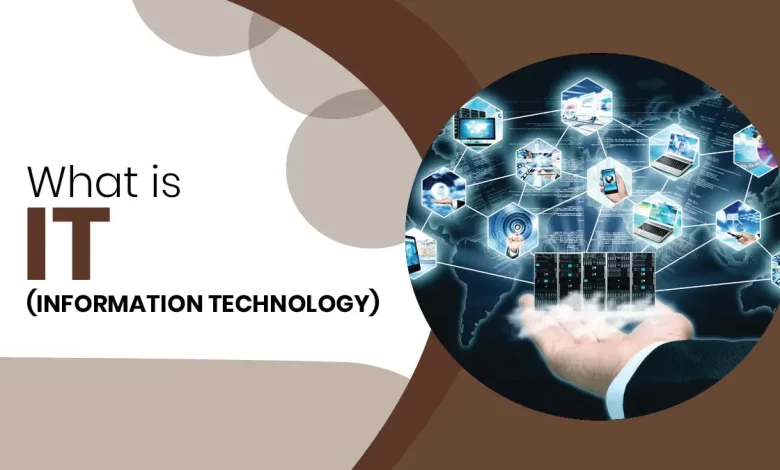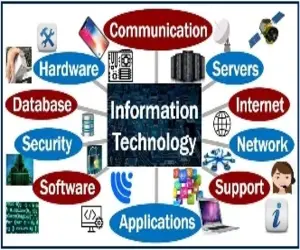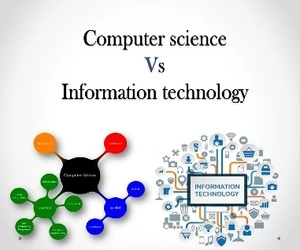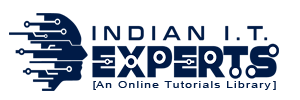What is IT | What is Information Technology?

Hello, Everyone Today we are going to discuss Information Technology. We know very well what the importance of IT in today’s era is. In this Information technology (IT) is the application of computer and telecommunications equipment to store, retrieve, transmit, and manipulate data, often in the context of a business or other enterprise.
The term is usually used synonymously with computers and computer networks, but also includes other information delivery technologies such as television and the telephone. Many industries are involved with information technology, including computer hardware, software, electronics, semiconductors, the Internet, telecommunications equipment, engineering, and healthcare, e-commerce, and computer services.
Table of Contents
What is Information technology (IT)?

Information technology (IT) is the use of any computer, storage, networking, and other physical equipment, infrastructure, and processes to create, process, store, secure, and exchange all forms of electronic data. Generally, IT is used in the context of business operations, as opposed to the technology used for personal or entertainment purposes. Business uses of IT involve both computer technology and telecommunications.
The Harvard Business Review coined the term “information technology” to distinguish between purpose-built machines designed to action within a limited scope and general-purpose computing machines that may be programmed for a variety of tasks. As the IT industry matured in the mid-twentieth century, computing capacity increased while device costs and energy consumption decreased—a cycle that continues today as new technologies emerge.
The Origin of Information Technology
Information technology: The study or use of systems (especially computers and telecommunications) to store, retrieve, and transmit information By this definition, you could say that information technology is about 65,000 years old, approximating the age of the earliest known cave paintings where humans were recording what they saw in everyday life.
Information technology is no stranger to development; it develops hand in hand with humans and our insatiable thirst to move forward. From ancient cave drawings to letters and words, the complexity of what we can create is only limited by how long it takes us to improve information technology.
In 1945, the development of the “stored program” concept allowed programmes to be read into a computer. This development laid the groundwork for the phenomenal achievements that would occur in IT for the next 50 years.
What is included in information technology?
The IT department ensures that the organization’s systems, networks, data, and applications are all connected and working properly. The IT team handles three key areas.
deploys and maintains business applications, services, and infrastructure (servers, networks, and storage);
Monitoring, optimizing, and troubleshooting the performance of applications, services, and infrastructure; as well as
Oversees the security and governance of the applications, services, and infrastructure.
Most IT employees have different responsibilities within the team that is broken down into several key areas, including.
Monitoring of an IT environment, including systems, networks, and applications.

Administrators
Handle the day-by-day deployment, operation, and Monitoring of an IT environment, including systems, networks, and applications.
Support
Help desk personnel answer questions gather information, and direct troubleshooting efforts for hardware and software.IT support frequently includes IT asset and change management, assisting administrators with procurement, and handling data backup and recovery.
Application
Applications can be coded in a wide range of popular languages and can be integrated with other applications to create smooth and seamless interactions between different applications.
Compliance
IT staff plays a major role in securing and monitoring access to business data and applications to ensure that such resources are used by established business governance policies that meet regulatory requirements.
What is the significance of information technology?
- Data processing plays an important role in these core business practices, which include, among others.
- Product Development and Design
- Marketing and market research;
- Sales and invoices;
- Customer growth and retention;
- Accounting and Taxes
- HR and Payroll, as well as
- Regulatory compliance.
- Computing has entered practically every part of business and our personal lives. The ubiquity of computing, also known as pervasive computing, is another reason why IT is important. Computing devices have evolved far beyond personal computers and servers. Today, all businesses and most individuals own and use multiple computing devices, including phones, tablets, laptops, game consoles, and even doorbells, thermostats, vacuums, and many kitchen appliances.
- Virtually all of these devices, many of which are part of the IT, tap into the Internet, which interconnects billions of devices worldwide. It is a complex and potentially dangerous environment that requires IT expertise to manage, secure, maintain, and ensure reliability.
What are the examples of Information technology (IT)?
So how exactly is IT involved in day-to-day business? Consider five typical examples of IT and teams at work.
Server upgrade:

One or more data Centre servers nearing the end of their operational and maintenance lifecycles IT staff will select and purchase replacement servers, configure and deploy the new servers, backup applications and data on the existing servers, and transfer that data and applications to the new servers.
Security monitoring:
Businesses regularly use tools to monitor and log activity across applications, networks, and systems. IT staff receive alerts of potential threats or non-compliance behavior, such as a user accessing a restricted file. Strives to investigate logs and other reporting tools to determine the root cause of an alert and respond quickly to address the threat; driving frequent change And improvements to the security posture that will result in the same future alerts can prevent such incidents.
New Software:
The Company determined that a new mobile application that would allow customers to log in and access account information or perform other transactions from smartphones and tablets was required. Operations staff post each iteration of the new mobile application to download and deploy the app’s back-end components across the organization’s infrastructure.
Business improvements:
A business needs high availability from a critical application to help with revenue or business continuity strategies. IT staff may be called upon to create a high-availability plan. This can be combined with enhancements in data storage security and recovery.
User Support:
The developers are building a major upgrade to a critical business application. Developers and administrators will collaborate to create new documentation for the upgrade. Allows a select group of users to try out the new version, as well as develop and deliver extensive training that prepares all users for the final release of the new version.
Information technology VS Computer Science

- While researching careers in IT, you are likely to come across the term “computer science.” While there is overlap between IT and computer science, the two are separate disciplines with different courses of study to prepare for a career in either field.
- It is commonly associated with the application of technology to deal with business issues.
- IT professionals work with a variety of technologies, such as server operating systems, communications equipment, and software and applications.
- Proficiency in IT is required to identify the hardware and software components that must be used to enhance a specific business process.
- IT workers are oriented towards evolving technologies such as hardware systems, OSes, and application software.
- Computer science focuses on the logic and design of the component base that IT specialists use to assemble business systems.
- They are also likely to move into more abstract technologies such as artificial intelligence (AI) and machine learning (ML).
- May be required to participate in hardware and software engineering work to develop computer scientist products.
- Pursuing a career in computer science requires a strong math background. Much of computer science work involves developing algorithms and logic and writing low-level code that enables computer systems to solve business problems.
Career in Information technology
There is a wide range of IT careers, each with different technical and managerial requirements. The most common IT job titles include the following:
Chief Information Officer (CIO)
This person is responsible for IT and the computer systems that support business goals.
Chief technology officer (CTO)
This individual sets the technology goals and policies within an organization.
IT Director
This person is responsible for the function of the business’s technological tools and processes. This role may also be called an IT manager or IT leader.
Sysadmin stands for System Administrator
This person configures, manages, supports, and troubleshoots a multi-user computing environment. Within a business, this role may be divided by technology, requiring an administrator or team dedicated to servers, desktops, network administration, virtualization, or other components and technologies.
Application Manager
This person’s role is focused on provisioning and managing high-value business applications such as Exchange.
Developer or software engineer
This person or team writes, updates, and tests code for computer programmes to meet internal or customer-oriented business objectives.
Chief IT Architect or IT Architect
This person checks and makes changes to IT functions to best support the business.
IT (Information Technology) Roles

Corporate
IT departments handle a lot more than just setting up printers and resetting forgotten passwords. The roles and responsibilities within an IT department are generally organized into three main categories.
Operations
Roles handle day-to-day IT tasks such as technical support, equipment management, and system software maintenance. Most of the interactions employees have with their IT department are with people in this role.
Infrastructure
Roles are responsible for the physical setup and maintenance of IT equipment such as network cabling, servers, routers, and individual workstations. Besides physical hardware, infrastructure roles may also be responsible for writing and updating proprietary software.
Governance
Includes the design of policies and procedures for the IT function. Proper governance of an IT system ensures that the services provided are matched with the needs of the business as a whole.
Conclusion
Information technology helps businesses, governments, and Singles increase their efficiency and effectiveness. Rapid improvements in hardware and processing capability compel consumers to purchase new, relevant technology. Regardless, organizations continue to demand new technological solutions, leaving room for new entrants, especially those with a unique concept. Firms that can find a niche market—or one with little competition—will find this industry attractive. Although barriers to entry remain high when entering existing markets, most potential entrants will find the overall industry unattractive.
FAQs
1. What is Information Technology (IT)?
Information technology (IT) is the use of any computer, storage, networking, and other physical equipment, infrastructure, and processes to create, process, store, secure, and exchange all forms of electronic data.
2. Why is IT an IT career?
It has a lot to offer, including multiple job opportunities, competitive pay, work-life balance, and more. If you’re ready to change careers, learn more about why IT is a great choice for your next step. With growth, high wages, and work-life balance, IT may be your next best move.
3. Is the IT industry stressful?
While more than a quarter of employees working in the IT sector are highly stressed, interestingly, more than half of these employees have only 0–4 years of work experience. It is also worth mentioning that not all stress is work-related.
4. Are IT jobs in high demand?
Information technology (IT) jobs are in high demand. This is due to the ever-evolving and rapidly growing world of technology and a lot of other factors. If you are considering starting a career in IT, there has never been a better time to do so. You can’t go wrong with networking or cyber security.
5. What Are the Drawbacks of IT Jobs?
You still need soft skills.
Many people enter IT because they think they will be sitting behind a computer all day. Unfortunately, you need to deal with people. You have to be a good communicator in every job in IT. You also have to deal with office politics and will be sitting behind a computer all day. Unfortunately, you need to deal with people. You have to be a good communicator in every job in IT. You also have to deal with office politics and managers.
6. Which IT sector is good for beginners?
There are eight of the best entry-level IT jobs.
1. Help desk analysts
2. PC Technician.
3. Computer operator
4. Software Developer.
5. Cyber security technician.
6. Front-End Web Developer
7. Quality assurance (QA) analyst.
8. Database developer
7. How long does it take to become an IT?
It takes two to four years to become an information systems (IT) technician. Most IT technicians will begin with a four-year bachelor’s degree in computer science, software engineering, or a related field.
8. Can I get a job in information technology without a technology degree?
Good Financial Cents agrees that many IT career paths do not require a degree like IT Technician. “As your skills progress and you get more experience, you can easily make $50,000 to $70,000 per year as you get into systems administration and network engineering,” said the article.




